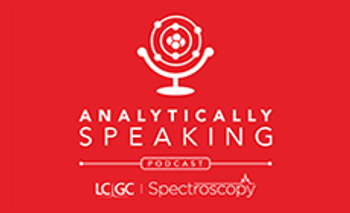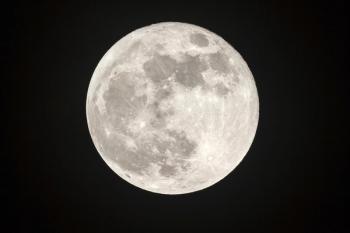
Best of the Week: Coverage of the EAS Conference, Detecting Lunar Water Ice
Key Takeaways
- NMR complements AlphaFold by focusing on molecular dynamics, revealing mechanisms like caspase-9 activation and ALS-related phase separation.
- VNIR spectroscopy's effectiveness in detecting lunar water ice is influenced by particle size, shape, and phase angle, affecting spectral signatures.
Top articles published this week include our coverage of the 2025 Eastern Analytical Symposium (EAS) conference and a recap of a study that detected lunar water ice using visible and near infrared (VNIR) spectroscopy.
This week, Spectroscopy published a variety of articles highlighting recent studies in several application areas. Key techniques highlighted in these articles include nuclear magnetic resonance (NMR), visible and near-infrared (VNIR) spectroscopy, and Fourier transform infrared (FT-IR) spectroscopy. Happy reading!
Lewis Kay, a professor at the University of Toronto and senior scientist at the Hospital for Sick Children, delivered an award lecture about the important role that NMR remains essential in the age of AlphaFold. Although algorithms now predict static protein structures with high accuracy, Kay emphasized that biology depends on dynamics, which is how molecular machines move, interact, and regulate activity (1). His laboratory has pushed NMR to probe large complexes by engineering long-lived methyl signals, enabling insights into systems like the apoptosome and biomolecular condensates (1). The studies that Kay and his team have conducted have revealed mechanisms of caspase-9 activation and links between phase separation and ALS. Kay concluded that AlphaFold empowers, rather than replaces, NMR by freeing it to focus on motion instead of fold prediction (1).
A recent study explored how VNIR spectroscopy can assist in locating and quantifying lunar water ice, which is crucial for future human activity on the Moon. The researchers found that particle size, shape, and phase angle significantly influence VNIR spectral signatures, affecting ice detection accuracy (2). The coarser and spherical ice particles show distinct spectral behaviors, which directly impact reflectance and absorption. The researchers also found that high phase angles enhance visible-light reflectance, suggesting optimal conditions for ice detection (2). The NIR absorption bands were sensitive to low ice concentrations, enabling detection even at minimal ice presence.
At the Eastern Analytical Symposium, Adam Hopkins of Metrohm argued that modern spectroscopy must prioritize usability over absolute analytical perfection (3). He emphasized the gap between academic environments, which reward precision and configurability, and industrial settings, where fast, reliable, and workflow-friendly instruments are essential. Hopkins highlighted the success of portable spectrometers as proof that fit-for-purpose tools often outperform highly complex systems in real-world use (3). He described effective instrument design as a balance of usability, robustness, and relevance, supported by automation and streamlined workflows. Ultimately, he noted that “good enough” performance is not a compromise but the key to practical, widely adopted analytical technology (3).
Geraldine L. Richmond, Presidential Chair in Science at the University of Oregon, received the 2025 NYSAS Gold Medal for her research on molecular interactions at liquid interfaces. Using nonlinear optical techniques such as vibrational sum frequency generation and scattering spectroscopy, she has revealed how water, surfactants, and polymers behave on planar and curved surfaces, advancing fields from environmental chemistry to drug delivery (4). Richmond’s EAS award symposium showcased both her technical innovations and her focus on real-world impact, as well as her influential mentorship and leadership in supporting women in science (4).
This mini-tutorial explains how data preprocessing (DP) converts raw FT-IR ATR spectra into reliable inputs for chemometric modeling by removing noise, baseline drift, scattering, and intensity variation. The tutorial outlines key DP techniques, including normalization, scatter correction, centering, scaling, baseline correction, and derivatives, and shows how these steps enhance accuracy, reproducibility, and interpretability in multivariate analyses like principal component analysis (PCA) and partial least squares (PLS) (5). Case studies in forensic ink analysis, honey authentication, and biomedical diagnostics demonstrate that customized preprocessing pipelines greatly improve spectral discrimination. The article stresses testing multiple DP combinations, documenting workflows, and developing standardized metrics to ensure consistent and meaningful infrared spectroscopic analysis (5).
References
- Hroncich, C. Lewis Kay on NMR’s Expanding Role in the Post–AlphaFold Era. Spectroscopy. Available at:
https://www.spectroscopyonline.com/view/lewis-kay-nmr-role-post-alphafold-era (accessed 2025-11-20). - Wetzel, W. Detecting Lunar Water Ice Using VNIR Spectroscopy. Spectroscopy. Available at:
https://www.spectroscopyonline.com/view/detecting-lunar-water-ice-using-vnir-spectroscopy (accessed 2025-11-20). - Hroncich, C. Balancing Performance and Usability in Analytical Tools. Spectroscopy. Available at:
https://www.spectroscopyonline.com/view/fit-for-purpose-spectroscopy (accessed 2025-11-20). - Hroncich, C. Geraldine Richmond Honored at EAS for Pioneering Research in Molecular Interfaces. Spectroscopy. Available at:
https://www.spectroscopyonline.com/view/geraldine-richmond-nysas-gold-medal-molecular-interfaces (accessed 2025-11-20). - Workman, Jr., J. Mini-Tutorial: Cleaning Up the Spectrum Using Preprocessing Strategies for FT-IR ATR Analysis. Spectroscopy. Available at:
https://www.spectroscopyonline.com/view/mini-tutorial-cleaning-up-the-spectrum-using-preprocessing-strategies-for-ft-ir-atr-analysis (accessed 2025-11-20).
Newsletter
Get essential updates on the latest spectroscopy technologies, regulatory standards, and best practices—subscribe today to Spectroscopy.





